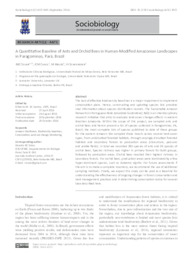A quantitative baseline of ants and orchid bees in human-modified Amazonian landscapes in Paragominas, Pará, Brazil.
A quantitative baseline of ants and orchid bees in human-modified Amazonian landscapes in Paragominas, Pará, Brazil.
Autoria: SOLAR, R. R. C.; CHAUL, J. C. M.; MAUES, M.; SCHOEREDER, J. H.
Resumo: The lack of effective biodiversity baselines is a major impairment to implement conservation plans. Hence, constructing and updating species lists provides vital information about species distribution records. The Sustainable Amazon Network (in Portuguese Rede Amazônia Sustentável; RAS) is an interdisciplinary research initiative that aims to evaluate land-cover changes effects in eastern Brazilian Amazonia. Within the scope of this project, we sampled ants and orchid bees and herein present a list of species collected in Paragominas, PA, Brazil; the most complete lists of species published to date of these groups for the eastern Amazon. We sampled these insects across several land-cover types, from undisturbed primary forest, through varyingly disturbed primary and secondary forests to production areas (silviculture, pastures and arable fields). In total we recorded 285 species of ants and 36 species of orchid bees. Species richness was higher in primary forests for both groups, followed by production areas. Orchid bees reached their highest richness in secondary forests. For orchid bees, production areas were dominated by a few hyper-dominant species, such as Eulaema nigrita. We acknowledge that the use of different sampling methods would collect additional species, and we recommend this for future assessments if the aim is to make a complete inventory. We expect this study can be used as a baseline for understanding the effectiveness of ongoing changes in forest conservation and land management practices. Finally, this list is of suitable importance in determining conservation status for several taxa described here.
Ano de publicação: 2016
Tipo de publicação: Artigo de periódico
Unidade: Embrapa Amazônia Oriental
Palavras-chave: Biodiversidade, Conservação, Floresta Tropical, Inseto, Monitoração, Uso da Terra
Observações
1 - Por padrão são exibidas publicações dos últimos 20 anos. Para encontrar publicações mais antigas, configure o filtro ano de publicação, colocando o ano a partir do qual você deseja encontrar publicações. O filtro está na coluna da esquerda na busca acima.
2 - Para ler algumas publicações da Embrapa (apenas as que estão em formato ePub), é necessário ter, no celular ou computador, um desses softwares gratuitos. Sistemas Android: Google Play Livros; IOS: iBooks; Windows e Linux: software Calibre.
Acesse outras publicações
Acesse a Base de Dados da Pesquisa Agropecuária (BDPA) para consultar o acervo completo das bibliotecas da Embrapa.

